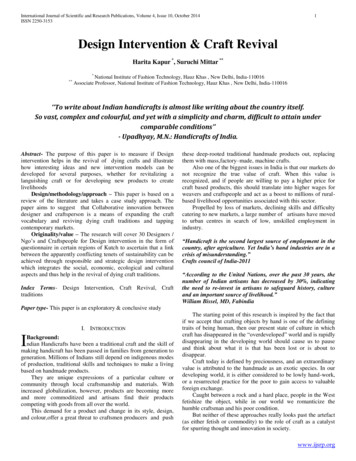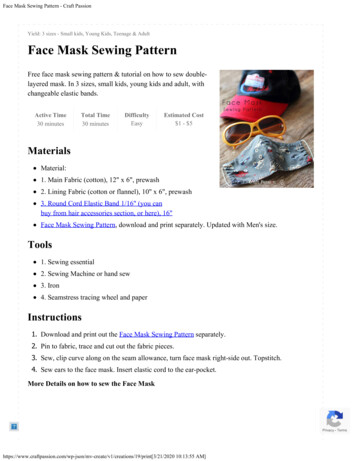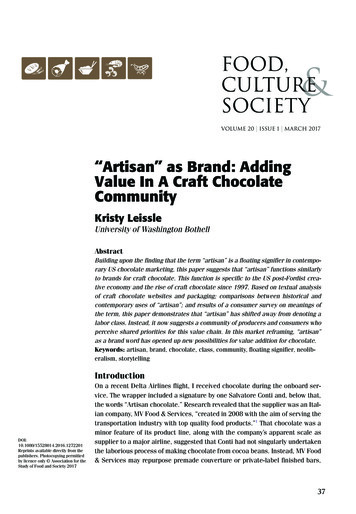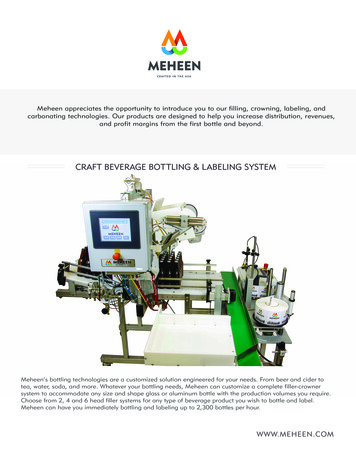
Transcription
International Journal of Scientific and Research Publications, Volume 4, Issue 10, October 2014ISSN 2250-31531Design Intervention & Craft RevivalHarita Kapur *, Suruchi Mittar *****National Institute of Fashion Technology, Hauz Khas , New Delhi, India-110016Associate Professor, National Institute of Fashion Technology, Hauz Khas , New Delhi, India-110016‘‘To write about Indian handicrafts is almost like writing about the country itself.So vast, complex and colourful, and yet with a simplicity and charm, difficult to attain undercomparable conditions’’- Upadhyay, M.N.: Handicrafts of India.Abstract- The purpose of this paper is to measure if Designintervention helps in the revival of dying crafts and illustratehow interesting ideas and new intervention models can bedeveloped for several purposes, whether for revitalizing alanguishing craft or for developing new products to createlivelihoodsDesign/methodology/approach – This paper is based on areview of the literature and takes a case study approach. Thepaper aims to suggest that Collaborative innovation betweendesigner and craftsperson is a means of expanding the craftvocabulary and reviving dying craft traditions and tappingcontemporary markets.Originality/value – The research will cover 30 Designers /Ngo’s and Craftspeople for Design intervention in the form ofquestionnaire in certain regions of Kutch to ascertain that a linkbetween the apparently conflicting tenets of sustainability can beachieved through responsible and strategic design interventionwhich integrates the social, economic, ecological and culturalaspects and thus help in the revival of dying craft traditions.Index Terms- Design Intervention, Craft Revival, Crafttraditionsthese deep-rooted traditional handmade products out, replacingthem with mass,factory–made, machine crafts.Also one of the biggest issues in India is that our markets donot recognize the true value of craft. When this value isrecognized, and if people are willing to pay a higher price forcraft based products, this should translate into higher wages forweavers and craftspeople and act as a boost to millions of ruralbased livelihood opportunities associated with this sector.Propelled by loss of markets, declining skills and difficultycatering to new markets, a large number of artisans have movedto urban centres in search of low, unskilled employment inindustry.“Handicraft is the second largest source of employment in thecountry, after agriculture. Yet India’s hand industries are in acrisis of misunderstanding.”Crafts council of India-2011“According to the United Nations, over the past 30 years, thenumber of Indian artisans has decreased by 30%, indicatingthe need to re-invest in artisans to safeguard history, cultureand an important source of livelihood.”William Bissel, MD, FabindiaPaper type- This paper is an exploratory & conclusive studyI. INTRODUCTIONIBackground:ndian Handicrafts have been a traditional craft and the skill ofmaking handicraft has been passed in families from generation togeneration. Millions of Indians still depend on indigenous modesof production, traditional skills and techniques to make a livingbased on handmade products.They are unique expressions of a particular culture orcommunity through local craftsmanship and materials. Withincreased globalization, however, products are becoming moreand more commoditized and artisans find their productscompeting with goods from all over the world.This demand for a product and change in its style, design,and colour,offer a great threat to craftsmen producers and pushThe starting point of this research is inspired by the fact thatif we accept that crafting objects by hand is one of the definingtraits of being human, then our present state of culture in whichcraft has disappeared in the “overdeveloped” world and is rapidlydisappearing in the developing world should cause us to pauseand think about what it is that has been lost or is about todisappear.Craft today is defined by preciousness, and an extraordinaryvalue is attributed to the handmade as an exotic species. In ourdeveloping world, it is either considered to be lowly hand-work,or a resurrected practice for the poor to gain access to valuableforeign exchange.Caught between a rock and a hard place, people in the Westfetishize the object, while in our world we romanticize thehumble craftsman and his poor condition.But neither of these approaches really looks past the artefact(as either fetish or commodity) to the role of craft as a catalystfor spurring thought and innovation in society.www.ijsrp.org
International Journal of Scientific and Research Publications, Volume 4, Issue 10, October 2014ISSN 2250-3153We may lament the loss of the beautiful objects we nowview in museums, but what if the ultimate value of craft lies notin the artefact but rather in the process by which it comes to be? (Ken Botnick, Ira Raja, 2011)And it is this process which seems to be getting lost as theartisans are trained in the art forms by their ancestors overgenerations and craft was not about making a simple product.Rather, it was about a historic legacy of generations andcenturies, a tedious brutal labour and a proud skill, a battlebetween tradition and industrial modernity, an expression ofunique style and a vision of revival, all connected to the heartand spirit of each individual artisan. ( Alexandra Soteriou,1998)Has Indian design, in fifty years of the country’sindependence, empowered the crafts community to become“freshly involved and “seek solutions themselves” on how toresolve this problem of designing for new markets? Havedesigners asked the right questions of the crafts community tolead to such empowerment?Perhaps it is now time to do so. “With adequate socialopportunities, individuals can effectively shape their own destinyand help each other. They need not be seen primarily as passiverecipients of the benefits of development programs.”( PoonamBir Kasturi,2005)While design intervention in crafts is welcomed by some asa necessity and an opportunity for exploring new prospects andhelp in craft revival, it is often considered by others as a threat.It is however argued that a link between the apparentlyconflicting tenets of sustainability can be achieved throughresponsible and strategic design innovation which integrates thesocial, economic, ecological and cultural aspects.In short, collaborative innovation between designer andcraftsperson is a good means of expanding the Craftvocabulary and tapping contemporary markets.II. DEFINING CRAFT‘‘‘‘Crafts can be defined as “those activities that deal with theconversion of specific materials into products, using primarilyhand skills with simple tools and employing the localtraditional wisdom of craft processes.Such activities usually form the core economic activity of acommunity of people called ‘craftsmen’.” ( Professor M.P.Ranjan )One definition states that crafts developed out of necessity tofulfil everyday needs of people. The products and objects madewere for personal use and were instrumental in expressing theirindividuality and their way of life. The very act of creation gavea new meaning to their life, to their self expression and to therituals, and also helped to develop an aesthetic sensibility. In theIndian context crafts have been both for personal use and anexpressional fulfilment and economic activity. It evolved out ofbeing a product of use, then was ornamented and given anaesthetic appeal to it.( Dhamija, 1979).2A craftsperson is one who is skilled in a craft technique andthough he may produce a number of similar objects, each onehowever expresses the maker’s creativity.(Jasleen Dhamija-2003)It can also be defined as a personal journey of thecraftsperson where the main objective is self expression. Thepersonalization, imperfections imparted because of hand workand use of indigenous tools and skills are the factors thatdifferentiate “craft” from a commodity. (Design Intervention andits execution in Crafts of India-Amita Panda )III. CURRENT STATE OF THE CRAFT INDUSTRYToday, an argument, an attitude faces crafts and artisans inIndia. This is the argument of economics, of sustainability, ofmarketability, which is the argument of financial survival (CraftsCouncil of India- April 2011)One question is still unsolved is and unanswered. What is thestate of Craft & craftsmen in India? This question carries a hugeand thick question mark at its end.India, no doubt is a very big country. It is big also because ofits diversity and racial character. More than 3000 castes, 432tribal communities, believers of Hinduism, Islam, Christianity,Sikh, Jain, Buddhism and Zoroastrian have been living togethersince centuries. Over 1650 dialects are spoken by the people ofIndia. The harmony among the people of India is worthmentioning.The planners and policy makers of India have beenaddressing many problems and concerns of this country. Theyare also addressing the need of the craftsmen and theircraftsmanship but probably the issue is so vast and complicatedthat the issue has not been touched in complete form.( GandhiNational Centre for the Arts- Under UNESCO’s Programme onCultural Industries and Copyright Policies and Partnerships)“An estimated 71% of artisans work as family units and 76%attribute their profession to the fact that they have learnt familyskills.”Fab IndiaWhile crafts received royal and aristocratic patronage duringpre-Independence days and played a central role in Gandhi'sindependence struggle, they have slowly lost relevance with theadvent of industrialization.Currently, the sector carries the stigma of inferiority andbackwardness, and is viewed as decorative, peripheral and elitist.This is compounded by the Government's treatment of crafts as asunset industry, which has resulted in a lack of well-developedpolicies and programs to protect and strengthen the ecosystemfor artisans.Traditional crafts have largely been marginalized by massproduced consumer goods, which tend to be cheaper due to theeconomies of scale associated with mechanization.The nature of the crafts sector and challenges faced byartisans reduces their ability to compete with machine-madeproducts .Catering to the mainstream market often necessitates adecline in quality and /or workmanship, leading to the eventualloss of skills over a few generations.www.ijsrp.org
International Journal of Scientific and Research Publications, Volume 4, Issue 10, October 2014ISSN 2250-3153IV. FACTORS AFFECTING THE DYING OF CERTAINCRAFT TRADITIONSArtisans were traditionally an essential part of the villageeconomy, producing everyday utilitarian objects catered towardslocal markets, using designs and motifs that were of significanceto their communities.However, with the advent of industrialization and increasingurbanization of markets for crafts, the historical artisan-consumerrelationship has broken down, and largely been replaced bytraders. This has rendered artisans' knowledge and skill, acquiredover generations, virtually useless and made crafts anunsustainable source of livelihood. (Crafting a LivelihoodBuilding sustainability for Indian Artisans-William Bissel,Managing Director, Fabindia )Also the marketplace isn’t what it used to be. In the recentpast, globalization has brought great changes across the world.The key characteristic of today’s global market is the speed withwhich the demand for a product and change in its style, design,and colour, offer greater opportunities as well as threats toproducers.The precarious nature of handmade craft markets invitesstrategic approaches to reach global consumers. But, delayedresponse can push these deep-rooted traditional handmadeproducts out, replacing them with mass, factory–made, machinecrafts. (Vanaja Menon Vadakepat, Faisal Al Khateeb- 2012)V. ROOTS OF INDIAN DESIGNIndia’s oral culture and its intense religious mysticism mightgive one the idea that there is an absence of rational thinking andscientific systems, but this is far from the truth.Historically, it is evident from the Mohenjo-Daro-Harappaexcavations that, as early as 2500 BC, there was highlydeveloped architecture, town planning, and technology in manyplaces. India’s traditional knowledge was highly organized andmeticulously articulated. Even in the arts, there were extremelydetailed canons and highly sophisticated structured treatises.Arts and crafts have always been an integral part of India’srich tradition and heritage. They are in fact the cultural symbolsof the nation. These art forms are unique and demand a highadroitness. The artisans are trained in the art forms by theirancestors over generations.Indian art forms are well popular all over the globe since thewake of ancient civilization. The artisans have transformed allthe art forms from mere passion to a real economic activity overthe past few decades unconsciously by acquiring basic businessacumen. ( Dr.P.T. Vijayshree, B.Hema- 2011)“Ancient India had Shilpa Shastra for sculpture, Natya Shastrafor dance, Sangeetha Ratnakara for music, VishnuDharmottara for art, and Vaastu Shastra for architecture.3VI. DESIGN THINKINGDesign is currently considered a cross-functional andmultidisciplinary innovation activity, capable of making sense ofsocial challenges while devising strategic and holistic solutionsto support competitiveness. It is considered a fundamentalingredient in business innovation through its ability to shapeideas and translate them into practical and appealing propositionsfor users, while improving national performance. ( MarziaMortati and Beatrice Villari )VII. THE DESIGNER-AS-FACILITATORDesign innovations in India’s fashion products result from afusion of modern technologies and traditional craft skills. Thedesign process in fashion begins with research and observation.The uniqueness of a designer’s creation lies in the interpretationof design sources. Sources of inspiration exist everywhere;anything visual, tactile, indeed sensual, can lead to inspiration indesign.In India the craft and design sectors share a symbioticrelationship. Through craft the designer connects with the naturalworld and the collective past. Traditional craft skills are adaptedto contemporary design (Sanjeev Kumar and Nandini Dutta2011)Designers bridge the gap between the market and the artisan,as today the artisan is geographically apart from his/her client, tobe able to understand his/her aesthetic and socio-cultural needs.Designers help in finding the relevance of craft with respectto the artisan, the consumer and to the global market.Designers are thus an interface, between the past and thepresent, the traditional and the modern, trying to match craftproduction to the needs of modern times and demands (Sethi,2005)Designers should be trained not only to solve problems, butwhat is more important they should be trained to help otherssolve their own problems.One of the most valuable functions of a good designer todayis to ask the right questions and of those concerned so that theybecome freshly involved and seek a solution themselves.(Charles and Ray Eames-“India Report )Also the biggest question today is that has Indian design, infifty years of the country’s independence, empowered the craftscommunity to become “freshly involved” and “seek solutionsthemselves” on how to resolve this problem of designing for newmarkets?Have designers asked the right questions of the craftscommunity to lead to such empowerment?Perhaps it is now time to do so. “With adequate socialopportunities, individuals can effectively shape their own destinyand help each other.”( Poonam Bir Kasturi- 2005)VIII. DESIGN INTERVENTIONSince Indian culture did not distinguish between applied artand fine art, there was no separate treatise on design”(Singanapalli Balaram)Design intervention is a process that involves designing newproducts; redesigning existing products, with changes in shape,size, colour, surface manipulation, function and utility; exploringnew markets and reviving lapsed markets; applying traditionalskills to meet new opportunities and challenges; and thewww.ijsrp.org
International Journal of Scientific and Research Publications, Volume 4, Issue 10, October 2014ISSN 2250-3153introduction of new materials, new processes, new tools andtechnologies.It is seen as an interface between traditional and modernity,that matches craft production to the needs of modern living.Design interventions have a very important role in every stepof the process in creation of the craft. They should focus on theidentity of a craft, its social and cultural relevance to its region,and the processes and materials involved, to incorporate theinterventions in the right situations, with efficient expectedoutcomes and reasoning’s.(Design Intervention and its executionin Crafts of India- Amrita Panda)Design interventions also assist in creating an awarenessamong artisans of methods, materials, tools, processes andclientele base.In many cases the artisans of a region have lost or rather donot have a documented form of the craft. Traditional crafts arememory based, and only memory is the knowledge bank of theirtraditional methods and materials (Design Intervention and itsexecution in Crafts of India- Amrita Panda)REVIVAL OF DYING CRAFTSWe’re living in a new golden era of good design, andcollaboration between designers & craftspeople is largely thereason to be thankful for.As consumers, we’re more aware of materials now – not justtheir visual and sensual appeal, but also where they come from,why they matter. We’re more curious about how things are madeand who made them (The Craft of Design- Joyce Lovelace-2013)Collaborative innovation between designer and craftspersonis a means of expanding the craft vocabulary and tappingcontemporary markets. It is also argued that a link between theapparently conflicting tenets of sustainability can be achievedthrough responsible and strategic design innovation whichintegrates the social, economic, ecological and cultural aspects. (Rebecca Reubens 2010)It has now been recognized that indigenous innovations arecrucial for any developing nation in order to achieve cumulativegrowth, both economically and socially.These innovations, as they will be mostly in the form ofappropriate modifications in the existing products, will requirefurther critical interventions and hand-holding efforts for theirtransition into markets.Design intervention can help bring in the much neededempathetic understanding and holistic vision to connect andintegrate the various efforts towards a positive outcome. Onewould come across amazing indigenous innovations in India thatcan be developed into marketable products and thereby help increating business success. These could provide vital directionsfor a country like India, to transform into an innovation-driveneconomy. ( Ascertaining the Scope for Design Interventions fortheir Successful Commercialization- Ravi Mokashi-Punekar,Shashank Mehta- 2011)REFERENCES[1]Research Papers, Journals, Editorial, Essays:Craft and Design-What's the Distinction ?, by Howard [7][8][9][10][11][12][13][14][15][16][17]4The adaptive capacity of rural crafts in the face of global challenges- JuanCarlos Pacheco Contreras , Pontificia Universidad Javeriana, Colombia(2010)Craft Research and its context- KRISTINA NIEDDERER -University ofWolverhampton, UK, KATHERINE TOWNSEND- Nottingham TrentUniversity, UK- (2010)Weaving a knowledge tapestry of traditional crafts for modern fashiondesigners: an Indian experience- Sanjeev Kumar and Nandini Dutta- (2011)BUYERS’ PREFERENCES OF PRODUCT-DESIGN FOR PURCHASEOF SELECTED INDIAN HANDICRAFTS WITH SPECIALREFERENCE TO ORISSA STATE-DR. MANJUSMITA DASH, Volume2, Issue 6 (June, 2011)BUYERS’ PREFERENCES OF PRODUCT-DESIGN FOR PURCHASEOF SELECTED INDIAN HANDICRAFTS WITH SPECIALREFERENCE TO ORISSA STATE-DR. MANJUSMITA DASH, Volume2, Issue 6 (June, 2011)Beyond control: Rethinking industry and craft dynamics- MARTINWOOLLEY Coventry University, UK- (2011)EXPLORING INDIGENOUS INNOVATIONS:Ascertaining the Scope for Design Interventions for their SuccessfulCommercialization Shashank Mehta, Faculty of Industrial Design, NationalInstitute of Design (NID), Ahmedabad, & Ravi Mokashi- Punekar,Associate Professor, Department of Design, IIT GuwahatiProduct and Design Identity of India- Shashank Mehta, ActivityChairperson, Outreach and Industry Programmes & Projects, NationalInstitute of DesignDesigning Freedom-Poonam Bir Kasturi,(2002)Design Pedagogy in India: A Perspective-Singanapalli Balaram,2005Massachusetts Institute of Technology,Design Issues: Volume 21, Number4 (Autumn 2005)Reviving a Tradition-Giving Papermaking Back to India by AlexandraSoteriou (1998)Weaving Scale into Handicrafts- Fabindia, INNOVATION SPECIAL—BTMONITOR STUDY( 2010)Bamboo canopy: Creating new reference-points for the craft of the Kotwaliacommunity in India through sustainability- REBECCA REUBENS, DelftUniversity of Technology, The Netherlands (2010)Subtle Technology: The Design Innovation of Indian Artisanship- KenBotnick, Ira Raja. Massachusetts Institute of Technology, Design Issues:Volume 27, Number 4 Autumn 2011THE RAISING ERA OF ARTREPRENEURSHIP – A CASE STUDY ONSAIPA Dr.P.T. Vijayshree, B.Hema Vol : 3 Issue : 1, Nov’11 PP : RADITIONAL PRODUCT MARKETS Vanaja MenonVadakepat, New York Institute of Technology, Faisal Al Khateeb, NewYork Institute of Technology GLOBAL JOURNAL OF BUSINESSRESEARCH ,VOLUME 6 , NUMBER 4 ,2012Crafting social innovators: Designing collaborative, participative,networked solutions in urban contexts- Marzia Mortati and Beatrice VillariThe images of the future of craft and design students –professionalnarratives of working practices in 2020-Kristiina Soini- Salomaa and PiritaSeitamaa-Hakk arainen, University of Helsinki, Art, Design &Communication in Higher Education, Volume 11 Number 1, 2012 IntellectLtd Article. English language. doi: 10.1386/adch.11.1.17 1Towards participatory design in craft anddesign education- HENNALAHTI and PIRITA SEITAMAA-HAKKARAINEN Department of HomeEconomics and Craft Science, University of Helsinki, Finland SavonlinnaDepartment of Teacher Education, University of Joensuu, FinlandCoDesign, Vol. 1, No. 2, June 2005, 103 – 117From then till now- Jasleen Dhamija, June 2003CRAFTING A LIVLIHOOD- Building sustainability for Indian ArtisansWilliam Bissel Managing Director, Fabindia, January 2013Cultural Mapping of India Under UNESCO’s Programme on CulturalIndustries and Copyright Policies and Partnerships- Indira Gandhi NationalCentre for the Arts, Contract No. 3240067111 / FC00588CRAFT ECONOMICS AND IMPACT STUDY Volume 1: Stage 1 &Stage 2, Crafts Council of India, April 2011www.ijsrp.org
International Journal of Scientific and Research Publications, Volume 4, Issue 10, October 2014ISSN 2250-3153[18] Design Intervention and its execution in Crafts of India-Amrita PandaM.Des, SemesterII, NIFT,[19] http://www.academia.edu/1768784/Design Intervention and its executionin Crafts of India[20] Design to connect encouraging Social Innovation and Sustainability. APresentation by: Shashank Mehta, Faculty of Industrial Design ActivityChairperson, Industry Programmes & Projects. National Institute of Design.Ahmedabad, INDIA, November 25, 2010[21] Handmade in India (World Bank Report( 2004)The Craft of Design- JoyceLovelace, 2013[22] Crafting Traditions for Posterity(Excerpts from a newspaper article)- JayaJaitley (The writer is founder and president of Dastkari Haat Samiti.)[23] 7C3MZ uqYFjYbmfk635L8eeubJgwU354/edit#slide id.g11f70e9f9 226[24] Towards sustainable production and consumption - the role of craftdesigner-makers by Alastair council.org.uk/files/download dfhttp://www.jiyo.net.in/about-us.php?id hy.pdfhttps://www.google.co.in/search?q craft and 20Amrita%20Panda%20%20Academia.edu.htmCraftmark: Handmade in India, Design Intervention Case Study, Source:http://www.iicd.ac.in/?p 793Shashank Mehta, 2011, Design Interventions for MSMEs, A Design ach.pdfAUTHORSFirst Author – Harita Kapur, National Institute of FashionTechnology, Hauz Khas , New Delhi, India-110016, emailharitakapur@gmail.comSecond Author – Suruchi Mittar, Associate Professor, NationalInstitute of Fashion Technology, Hauz Khas , New Delhi, India110016, email-suruchi.mittar@nift.ac.inwww.ijsrp.org
Propelled by loss of markets, declining skills and difficulty catering to new markets, a large number of artisans have moved to urban centres in search of low, unskilled employment in industry. “Handicraft is the second largest source of employment in the country











